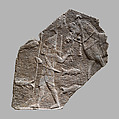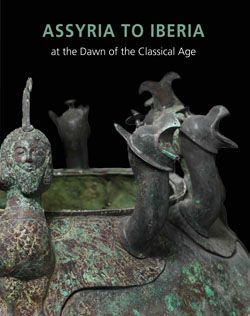Relief fragment: cavalryman leading his horse beside a stream
Not on view
This relief fragment dates to the time of the Assyrian king Sennacherib (r. 704-681 B.C.), and comes from the great Southwest Palace, called by Sennacherib the "Palace Without Rival," at Nineveh in northern Iraq. It shows an Assyrian soldier leading a horse beside a large river, and comes originally from a much larger scene depicting an Assyrian campaign that filled a room of the palace.
The soldier is equipped in typical Assyrian fashion with a high conical helmet, a short spear, a bow (seen with quiver on his back), and a short sword, worn at the hip and apparently attached to a strap running across the chest. The body armor, worn over typical Assyrian male clothing of a tunic and wrap, consists of scales that were made of leather or metal, and the hatched pattern seen on the legs above the high boots also represents some kind of protective covering. In his left hand the soldier holds the rein by which he leads the horse. The horse itself wears an elaborate harness, including ornamented cheek-pieces, a crescent-shaped crest rising from the top of the head, and a large tassel at chest-height. Horses were a key part of the Assyrian military, and some campaigns to the empire’s north and east were even fought for the purpose of acquiring them.
An unusual characteristic of later Assyrian palace reliefs depicting military campaigns is that they are filled with landscape imagery. In this case, a rushing river is shown as very rich because it is filled with fish. The fish appear to our eyes ‘above’ the water. Their completeness is the standard Assyrian solution to showing animals or objects underwater. Although overlapping and other devices were used extensively in the Assyrian reliefs to indicate spatial arrangements and create depth of field, showing elements complete and as they would appear unobstructed was often prioritized. The location of the campaign is uncertain, though other reliefs from the room suggest that the river may be the Tigris. They also show the river running through hilly and heavily wooded country, indicating an area to the north of the Assyrian heartland. Below the river the trees and landscape were depicted upside-down, a device used to show that the river ran through a steep valley.
This image cannot be enlarged, viewed at full screen, or downloaded.



